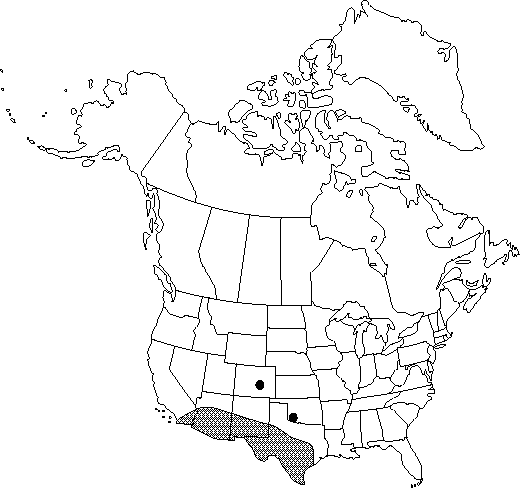Difference between revisions of "Clematis drummondii"
Fl. N. Amer. 1: 7. 1838.
FNA>Volume Importer |
FNA>Volume Importer |
||
| Line 20: | Line 20: | ||
}}<!-- | }}<!-- | ||
| − | --><span class="statement" id="st- | + | --><span class="statement" id="st-undefined" data-properties=""><b>Stems </b>scrambling to climbing with tendril-like petioles and leaf-rachises, 4-5 m or more. <b>Leaf</b> blade odd-pinnate, usually 5-foliolate; leaflets deltate to ovate, strongly 3-parted to 3-cleft, proximal leaflets sometimes 3-cleft, 1.5-5.5 × 0.5-4.5 cm, membranous to leathery; segments ovate, deltate, or linear, margins dentate; surfaces pilose, abaxially more densely so. <b>Inflorescences</b> usually axillary, 3-12-flowered simple cymes or compound with central axis or flowers solitary or paired. <b>Flowers</b> unisexual; pedicel slender, (1.1-)1.5-7 cm; sepals wide-spreading, not recurved, white to cream, oblong or elliptic to obovate or oblanceolate, (7-)9-13(-15) mm, abaxially and adaxially pubescent; stamens 40-90; filments glabrous; staminodes 17-35 when present; pistils 35-90. <b>Achenes</b> elliptic to ovate, 3-5 × l.5-2.5 mm, rimmed, short-silky; beak 4-9 cm.</span><!-- |
-->{{Treatment/Body | -->{{Treatment/Body | ||
| Line 26: | Line 26: | ||
|habitat=Chaparral, xeric scrub, oak scrub, and grasslands, pastures, fencerows, and other secondary sites, often along streams or on slopes | |habitat=Chaparral, xeric scrub, oak scrub, and grasslands, pastures, fencerows, and other secondary sites, often along streams or on slopes | ||
|elevation=0-2200 m | |elevation=0-2200 m | ||
| − | |distribution=Ariz.;Calif.;Colo.;N.Mex.;Okla.;Tex.;n Mexico | + | |distribution=Ariz.;Calif.;Colo.;N.Mex.;Okla.;Tex.;n Mexico. |
|discussion=<p>As with many other members of the subgenus, the leaves of Clematis drummondii are reputedly used in a poultice to treat irritations of the skin in humans and other animals.</p><!-- | |discussion=<p>As with many other members of the subgenus, the leaves of Clematis drummondii are reputedly used in a poultice to treat irritations of the skin in humans and other animals.</p><!-- | ||
--><p>Clematis coahuilensis D. J. Keil is found in central and north-central Mexico in habitats similar to those of C. drummondii; it is distinguished by ovate, entire to 3-lobed, leathery leaflets.</p> | --><p>Clematis coahuilensis D. J. Keil is found in central and north-central Mexico in habitats similar to those of C. drummondii; it is distinguished by ovate, entire to 3-lobed, leathery leaflets.</p> | ||
| Line 47: | Line 47: | ||
|habitat=Chaparral, xeric scrub, oak scrub, and grasslands, pastures, fencerows, and other secondary sites, often along streams or on slopes | |habitat=Chaparral, xeric scrub, oak scrub, and grasslands, pastures, fencerows, and other secondary sites, often along streams or on slopes | ||
|elevation=0-2200 m | |elevation=0-2200 m | ||
| − | |distribution=Ariz.;Calif.;Colo.;N.Mex.;Okla.;Tex.;n Mexico | + | |distribution=Ariz.;Calif.;Colo.;N.Mex.;Okla.;Tex.;n Mexico. |
|reference=None | |reference=None | ||
|publication title=Fl. N. Amer. | |publication title=Fl. N. Amer. | ||
|publication year=1838 | |publication year=1838 | ||
|special status= | |special status= | ||
| − | |source xml=https://jpend@bitbucket.org/aafc-mbb/fna- | + | |source xml=https://jpend@bitbucket.org/aafc-mbb/fna-data-curation.git/src/9216fc802291cd3df363fd52122300479582ede7/coarse_grained_fna_xml/V3/V3_972.xml |
|genus=Clematis | |genus=Clematis | ||
|subgenus=Clematis subg. Clematis | |subgenus=Clematis subg. Clematis | ||
|species=Clematis drummondii | |species=Clematis drummondii | ||
| − | |||
| − | |||
| − | |||
| − | |||
| − | |||
| − | |||
| − | |||
| − | |||
| − | |||
| − | |||
| − | |||
| − | |||
| − | |||
| − | |||
| − | |||
| − | |||
| − | |||
| − | |||
| − | |||
| − | |||
| − | |||
| − | |||
| − | |||
| − | |||
| − | |||
| − | |||
| − | |||
| − | |||
| − | |||
| − | |||
| − | |||
| − | |||
| − | |||
| − | |||
}}<!-- | }}<!-- | ||
-->[[Category:Treatment]][[Category:Clematis subg. Clematis]] | -->[[Category:Treatment]][[Category:Clematis subg. Clematis]] | ||
Revision as of 13:54, 27 July 2019
Stems scrambling to climbing with tendril-like petioles and leaf-rachises, 4-5 m or more. Leaf blade odd-pinnate, usually 5-foliolate; leaflets deltate to ovate, strongly 3-parted to 3-cleft, proximal leaflets sometimes 3-cleft, 1.5-5.5 × 0.5-4.5 cm, membranous to leathery; segments ovate, deltate, or linear, margins dentate; surfaces pilose, abaxially more densely so. Inflorescences usually axillary, 3-12-flowered simple cymes or compound with central axis or flowers solitary or paired. Flowers unisexual; pedicel slender, (1.1-)1.5-7 cm; sepals wide-spreading, not recurved, white to cream, oblong or elliptic to obovate or oblanceolate, (7-)9-13(-15) mm, abaxially and adaxially pubescent; stamens 40-90; filments glabrous; staminodes 17-35 when present; pistils 35-90. Achenes elliptic to ovate, 3-5 × l.5-2.5 mm, rimmed, short-silky; beak 4-9 cm.
Phenology: Flowering spring–fall (Mar–Oct).
Habitat: Chaparral, xeric scrub, oak scrub, and grasslands, pastures, fencerows, and other secondary sites, often along streams or on slopes
Elevation: 0-2200 m
Distribution

Ariz., Calif., Colo., N.Mex., Okla., Tex., n Mexico.
Discussion
As with many other members of the subgenus, the leaves of Clematis drummondii are reputedly used in a poultice to treat irritations of the skin in humans and other animals.
Clematis coahuilensis D. J. Keil is found in central and north-central Mexico in habitats similar to those of C. drummondii; it is distinguished by ovate, entire to 3-lobed, leathery leaflets.
Selected References
None.